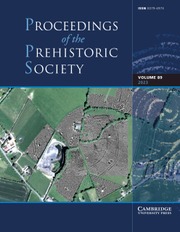No CrossRef data available.
Article contents
Siting, objectives and progress of the 1983 excavations (CRM)
Published online by Cambridge University Press: 28 November 2017
Extract
The line chosen for the access track cut through the rampart at an angle of about 30° at a point where it had already been partially eroded by animals, just north of the entrance gully on the eastern side of the fort. The uneroded parts of the rampart here stood little more than 50 cm high above the interior, and even allowing for the accumulation of material behind the rampart it seemed unlikely that the total depth of core material would be more than about a metre. It was thought that a section about 3 m wide could be dug in about a fortnight with a small team seconded from work elsewhere, allowing the basic structural character of the rampart to be recorded, testing the underlying ground surface for the possibility of earlier (palisaded?) lines of defence, and seeking dating material from either the rampart core or the deposits behind or beneath it. The presence of the external ditch might also be tested, either in the excavation trench or in the subsequent bulldozing work for the access road.
- Type
- Research Article
- Information
- Copyright
- Copyright © American Society of International Law 1992


